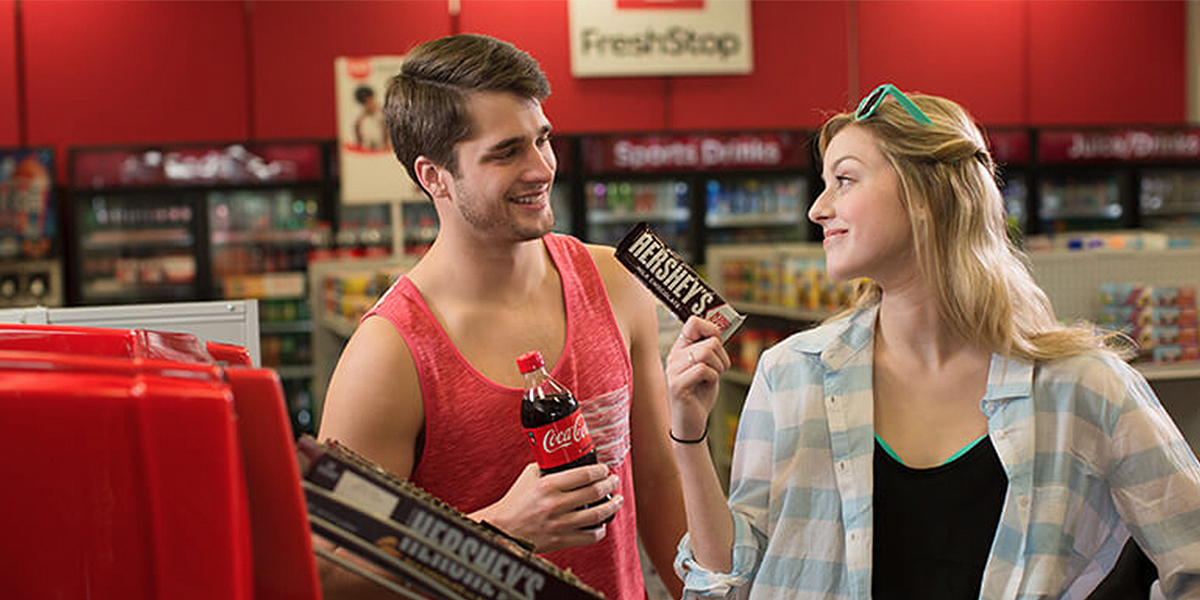
Maximize Sales with Food and Beverage Combos
How to turn that drink purchase into a bigger sale

As people more frequently eat away from home, convenience retailers have a prime opportunity to complement each thirst-quenching sip with a bite to eat. There exists a bridgeable gap between the 87% of single-serve beverages purchased for immediate consumption1, and the nearly 70% of those buys that don’t include food1.
It all starts with the realization that beverages are traffic drivers in convenience stores1.
“Many shoppers are simply on autopilot when they walk into a c-store,” says Stephanie Kowitz, Senior Manager, National Shopper Insights-Convenience Retail, The Coca-Cola Company. She explains that shoppers tend to “grab and go” when making a beverage purchase. The challenge to cross-sell is also heightened by the fact that foodservice is a relatively new concept in convenience retail, so store guests need to be educated about the wider assortment and better quality of edibles now available.
“Because beverages are the top product purchased in c-stores, operators can leverage that opportunity to sell an incremental food item.”
If retailers think about implementing strategies that connect beverage purchases with food purchases, the result will be a certain uptick in revenue. Kowitz advises, “Because beverages are the top product purchased in c-stores, operators can leverage that opportunity to sell an incremental food item.”
Connect the dots for shoppers
An easy and effective way to secure a dual buy is to help shoppers make a mental connection to drinks-plus-food by presenting them as one unit via merchandising and messaging.
Another means is understanding and addressing the desires and needs of each daypart. While morning captures the most in-store shopping trips, a major opportunity exists with snacking purchases between morning and lunch, as well as lunch and dinner2.
Here are other tips to facilitate the response you want to drive revenue:
- Place photos of a drink with an easily associated food item in a strategic location, such as displayed over the cold vault. Images can feature a sparkling beverage with salty snacks, bottled water with produce, or an energy drink with protein bars. CokeSolutions offers a valuable resource to help operators create customized marketing materials for their outlet. Check out Design Machine for hundreds of professionally produced point-of-sale templates and marketing materials.
- Merchandise the physical products together, locating barrel coolers or ambient beverage displays near food.
- Promote specially priced food and beverage products together in bundles.
- Reward your loyal base and pay attention to emerging customers.
Cater to Shopper Segments
Multicultural and millennial shoppers are important to convenience retailers. Millennials (ages 18-34) are the largest and fastest growing shopper group3, and 43% of Millennials are multicultural1.
“This age group also doesn’t carry an old mindset about foodservice in convenience stores, so they buy more,” Kowitz says. “They’re growing up with better meals and snacking solutions at all times.”
Establish ways to engage with millennials by using social media to discuss sales and promotions, or communicate via text alerts about special deals, tying a purchase to a social cause, or creating an outlet for self-expression.
While addressing the wants and needs of customer segments is smart, Kowitz advises retailers to remember that the whole is greater than the sum of the parts.
“Don’t lose sight of your loyal shoppers who have the potential to expand your shopper base by bringing their families and other adults with them,” says Kowitz.
“The key is talking to your shoppers as a whole, blended market—as everyone wants a quick, easy solution that provides good value,” she explains. “With minimal effort and cost, retailers can seize this opportunity to increase sales.”
Learn more about growing basket size with food and beverages by contacting your Coca-Cola representative for ideas.
Sources:
1. iSHOP study, © 2014, The Coca-Cola Company
2. DINE study, © 2013, The Coca-Cola Company
3. U.S. Census Bureau